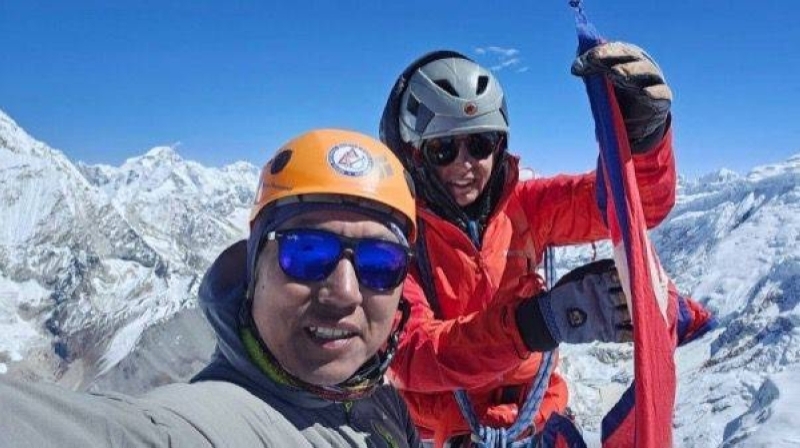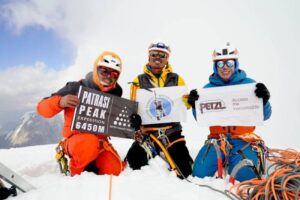Piolets d’Or 2024: Two virgin summits, four Nepali climbers, and a shot at mountaineering’s highest honor – The Himalayan Times – Nepal’s No.1 English Daily Newspaper
KATHMANDU:
Nepal’s new generation of climbers is once again rewriting the story of Himalayan alpinism. Two separate first ascents, one on Patrasi Peak in far-western Nepal and another on Beding Go in the Rolwaling valley, have propelled at least four Nepali climbers into the global spotlight, earning them nominations for the prestigious Piolets d’Or 2024, widely regarded as the Oscars of mountaineering.
The nominations mark not just individual triumphs but also a growing recognition of Nepal’s evolving climbing culturE, one that celebrates technical precision, alpine ethics, and self-reliant exploration beyond the commercial peaks of Everest and Manaslu.
The light and fast ascent of Patrasi I
In June 2024, three Nepali climbers, Vinayak Jaya Malla, Pasang Kami Sherpa, and Pasang Rinzee Sherpa, embarked on an ambitious expedition to scale Patrasi I (6,450m), a previously unclimbed mountain nestled deep within the Kanjiroba Himal of Jumla district. Their mission, part of the “Light and Fast” project, was as bold as it was pure: to attempt a first ascent in true alpine style, without fixed ropes or external support.
Setting off from Kathmandu on June 3, the team flew to Nepalgunj and then journeyed overland to Jumla before trekking to base camp. Their climb began on June 10, establishing successive camps at 5,700m and 6,000m before summiting the peak on June 12. Within four days, they had completed a round-trip that tested their endurance, skill, and commitment to minimalist mountaineering.
“The climb was tough and technical-completely different from the fixed-rope expeditions most of us are used to,” said Malla, an IFMGA-certified mountain guide who has summited Everest five times. “This kind of climbing brings out the real joy of mountaineering.”
For Pasang Rinzee Sherpa, the recognition holds deeper meaning. “It’s a proud moment for us. This nomination stands as a testament to the strength, skill, and spirit of Nepali alpinism,” he said.
The team’s ascent was supported by a Mount Everest Foundation (MEF) grant-the first ever awarded to a Nepali expedition. Established in 1955 in the United Kingdom, the MEF has supported over 2,000 expeditions and high-altitude research projects worldwide. For decades, its funding was exclusive to UK and Dutch climbers until it opened to Nepalis in 2023, marking a turning point in local expedition access.
Each member of the Patrasi team brought significant experience to the climb. Pasang Kami Sherpa, with ten Everest summits, and Pasang Rinzee Sherpa, with two, are both IFMGA aspirant guides. Together, they’ve guided on Everest, Lhotse, Dhaulagiri, and Ama Dablam-but Patrasi offered something new: isolation, raw beauty, and complete self-reliance.
“We were out of contact for eight days,” Malla recalled. “It was refreshing-to be cut off from the world and to rediscover what adventure really means.”
Malla believes western Nepal’s untouched peaks hold immense potential for sustainable climbing and tourism. “The mountains of Jumla and Humla could become a hub for authentic alpine experiences,” he said. “They represent the next frontier of Nepali mountaineering.”

Bedding Go
A new route in Rolwaling: The Friendship Ridge
Four months later, on October 13, 2024, another Nepali climber, Pasang Kidar Sherpa, joined hands with American mountain guide Danika Gilbert to carve a new line on Beding Go (6,125m) in the Gaurishankar range, near the Nepal-Tibet border. Their route, the “Friendship Ridge,” was established in alpine style-light, fast, and unsupported-true to the spirit of modern mountaineering.
Starting from a high camp at 5,100m, the pair traversed glaciated terrain along the northwest ridge, climbing through false summits and narrow traverses with sheer drops on either side-1,350 meters down to Tibet’s Rongshar Valley on one flank and 700 meters to Nepal’s Gaurishankar Khola on the other. After six grueling hours on a knife-edge ridge, they reached the summit at 12:07 p.m., standing with one foot in Nepal and one in Tibet.
The climb, graded V, AI 3+, TD, was achieved without fixed ropes, reaffirming their commitment to pure alpine style. Their route overlapped briefly with that of a Japanese team on the south face, but the upper section-above 5,500m-was entirely new terrain.
Porter support from Nangsal Tamang of Thalti was crucial in ferrying supplies to the 4,900m base camp. From there, the duo established their high camp and spent days scouting the right line through the glacier. The resulting route, “Friendship Ridge,” is now being documented for the American Alpine Journal.
For Pasang Kidar, one of only 14 IFMGA-certified guides from Rolwaling and the owner of Khangri Treks, the ascent was the realization of a long-cherished dream. “We wanted to climb something meaningful-something that represents friendship and equality in the mountains,” he said. This new route, the NW ridge of Beding Go, will provide future expedition teams with a challenge a bit more difficult than Ama Dablam peak in Nepal, or similar to Huandoy peak’s North Face route in Peru. This route is perhaps more accessible to other groups than nearby Langdung peak (6357m), which Pasang Kidar was part of the first ascent party in winter 2017, added Pasang Kidar.
Recognition beyond summits
Both the Patrasi and Beding Go ascents are nominated for the Piolets d’Or 2024, whose award ceremony will be held from December 9–12, 2025, in San Martino di Castrozza, nestled in the Italian Dolomites. For Nepali climbers, the nominations represent more than just personal accolades-they signal a shift in global perception.
Mingma, a record-holding climber, earned two prior nominations for scaling Bamongo Peak (2013) and Chobuje (2015). In 2018, a team comprising Pasang Kidar, Dawa Yangzum Sherpa, Dawa Gyalje Sherpa, and Nima Tenji Sherpa was also nominated for their first ascent of Langdung Peak.
For decades, Nepali climbers were celebrated primarily as high-altitude workers on commercial expeditions. Now, they are increasingly being recognized as innovators, athletes, and explorers in their own right.
With their blend of humility, technical mastery, and vision, these climbers are charting a new course for Nepali alpinism-one that’s not measured merely in meters climbed, but in mountains reimagined.














Post Comment